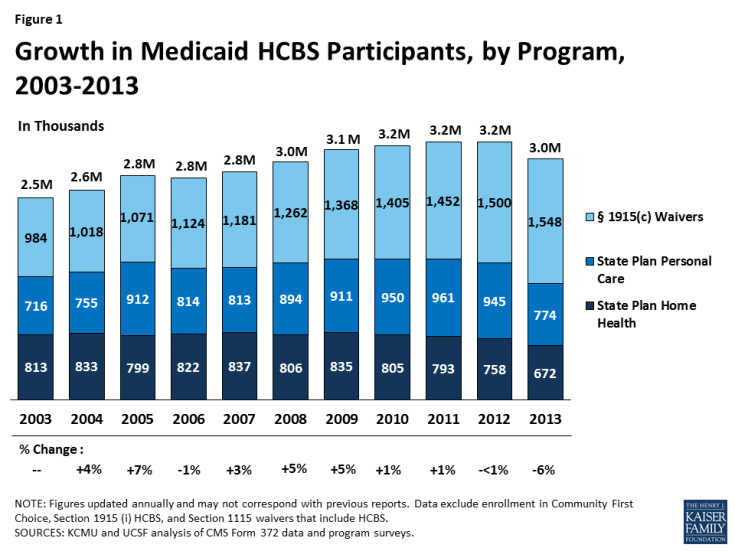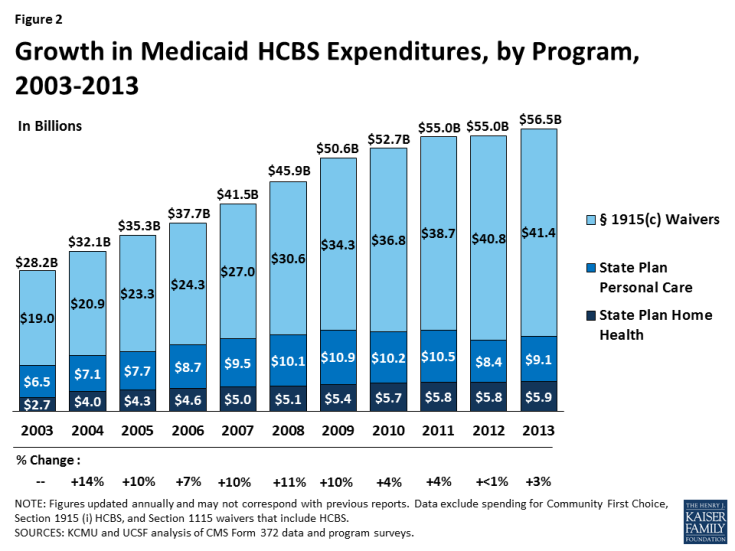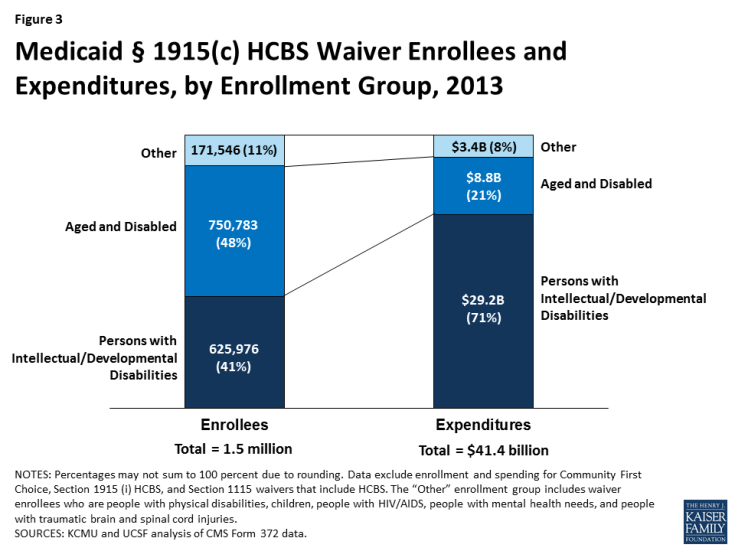Medicaid Home and Community-Based Services Programs: 2013 Data Update
As states continue to implement various aspects of the Affordable Care Act (ACA), developing and expanding home and community-based alternatives to institutional care remains a priority for many state Medicaid programs. 2013 marked the first time that home and community-based services (HCBS) accounted for a majority (51%) of national Medicaid long-term services and supports (LTSS) spending, increasing from 18 percent in 1995.1 The share of Medicaid LTSS spending devoted to HCBS has continued to rise, reaching 53 percent in 2014.0F2 At the same time, state Medicaid programs are operating at a time when state revenues are slowing, forcing more moderate spending growth and, as of 2016, continue to face the competing priorities of implementing the ACA’s streamlined eligibility and enrollment processes, determining whether to adopt the ACA’s Medicaid expansion, and pursuing a variety of delivery and payment system reforms.
This report summarizes the key national trends to emerge from the latest (2013) participant and expenditure data for the three main Medicaid HCBS programs: (1) the mandatory home health services state plan benefit, (2) the optional personal care services state plan benefit, and (3) optional § 1915 (c) HCBS waivers. It also briefly discusses the provision of Medicaid HCBS through § 1115 demonstration waivers and highlights findings from a 2015 survey of Medicaid HCBS participant eligibility, enrollment, and provider reimbursement policies, including those related to the U.S. Department of Labor (DOL) direct care worker rules and the Centers for Medicare and Medicaid Services’ (CMS) home and community-based settings rule. States also may provide HCBS through various options offered by the ACA, which are outside the scope of this report.
Key Findings: Trends in Medicaid HCBS Participants and Expenditures, 2003-2013
- In 2013, almost 3 million people accessed LTSS through one of the three main Medicaid HCBS programs (Figure 1). Within this population, the number of people receiving § 1915 (c) waiver services increased slightly from 2012 to 2013 (by 3%), while the number of people receiving personal care state plan services and home health state plan services decreased (by 18% and 11%, respectively). A total of 672,137 people received home health state plan services (in 50 states and DC), 774,243 received personal care state plan services (in 32 states), and almost 1.55 million were served through § 1915 (c) waivers (in 47 states and DC). The number of individual § 1915 (c) waivers declined slightly from 290 to 289 nationwide in 2013. States also may offer HCBS through the newer ACA options or § 1115 managed care programs instead of or in addition to these three authorities.
- In 2013, Medicaid HCBS expenditures for home health state plan services, personal care state plan services, and § 1915 (c) waivers totaled $56.5 billion, increasing slightly from 2012, and lower than the 10-year average of seven percent (Figure 2). In 2013, spending growth in HCBS programs was led by personal care state plan services (9%) followed by home health state plan services (2%), while § 1915 (c) waivers increased by only one percent.
- Per participant annual spending on Medicaid HCBS averaged $18,870 in 2013, but there was considerable variation among states and programs. Across states, Medicaid HCBS expenditures per participant served ranged from $9,641 in Michigan to $49,212 in Delaware. Per participant spending also varied across the three main HCBS programs, ranging from a national average of $8,827 for home health state plan participants to $26,768 for § 1915 (c) waiver participants. These program-to-program differences were due to the types and extent of services offered in the different home and community-based programs. Per participant spending also varied among § 1915 (c) waivers targeted to different beneficiary populations. For example, per participant spending in § 1915 (c) waivers targeted to beneficiaries with intellectual/developmental disabilities (I/DD) was considerably higher than for other beneficiary groups, reflecting the I/DD population’s relatively more intensive need for LTSS.
- The aged/disabled population made up the largest share of waiver enrollment (48%) but accounted for 21 percent of spending on waiver services in 2013 (Figure 3). People with I/DD accounted for 41 percent of HCBS waiver enrollment in 2013, but 71 percent of spending on waiver services was devoted to this population, again reflecting their more intensive need for LTSS relative to other groups.
- A minority of states use § 1115 demonstration waivers to deliver HCBS through capitated managed care. As of 2013, three states (Arizona, Rhode Island, and Vermont) do not operate any § 1915 (c) waivers and instead use § 1115 waivers to administer statewide Medicaid managed care programs that include all covered HCBS for all populations and services. Another five states (Delaware, Hawaii, New York, Tennessee, and Texas) use § 1115 waivers for capitated Medicaid managed care programs that include HCBS for at least some geographic areas and/or populations.
2015 Policies in Medicaid HCBS Programs
- In 2015, all states reported using cost controls in § 1915 (c) waivers, such as restrictive financial and functional eligibility standards, enrollment limits, or waiting lists. About 25 percent of § 1915 (c) waiver programs used financial eligibility standards that were more restrictive than those used to determine eligibility for Medicaid coverage for institutional care. However, six § 1915 (c) waivers used more restrictive functional eligibility criteria than those used for institutional care. More than one half of states offering personal care state plan services (59%, or 20 states) had some form of cost controls in place, with the majority utilizing service unit limitations. Over half of states (59%, or 30 states) had some form of expenditure or service restriction in place in their home health state plan programs.
- In 2015, more than 640,000 people were on 133 § 1915 (c) waiver waiting lists, and the average waiting time exceeded two years. The growth in the number of people on waiting lists grew by 10 percent from 2014 to 2015, outpacing the growth rate of 8.5 percent in the previous period. The average national waiting time for § 1915 (c) waiver services was 27 months, with wide variations among waivers for different target populations and across states. The average length of time a person spent on a waiting list ranged from four months for HIV/AIDS waivers to 43 months for I/DD waivers.
- The use of beneficiary self-direction as an alternative service delivery model was present in each of the three major Medicaid HCBS programs. The self-direction model includes initiatives such as beneficiary choice in the allocation of Medicaid service budgets and/or the selection and dismissal of service providers. Forty-three states (or 91%) with § 1915 (c) waivers permitted or required self-direction in at least one of their waivers in 2015. Of the states offering personal care state plan services, 24 (or 71%) permitted self-direction. In contrast, seven states (or 14%) allowed self-direction of home health state plan services in 2015.
- In 2015, seven states reported plans to restrict caregiver hours or make other policy changes in response to the DOL direct care worker minimum wage and overtime rules, and six states had cost or service caps on self-directed services in place in 2015. Seven states indicated that state funds were budgeted for direct care worker overtime pay in FY 2016, and five states indicated state funds were budgeted for worker travel time.
- Twenty-one states anticipated having to change state rules or policies as part of their transition to CMS’s rule defining the qualities of home and community-based settings, as of 2015. In addition, 11 states planned to submit information to CMS seeking to overcome the regulatory presumption that certain settings are institutional in nature.
- Provider reimbursement rates increased slightly from 2014 to 2015, for both home health and personal care agencies. The national average reimbursement rate per visit for home health agencies was $92.69 and $93.93 in 2014 and 2015, respectively. The hourly reimbursement rate for agencies providing personal care services increased slightly ($18.82 in 2015 and $18.73 in 2014).
Over the past three decades, the increase in access to community-based alternatives to institutional care has resulted in some rebalancing of national Medicaid LTSS dollars, but the size and scope of Medicaid HCBS programs vary across states. Section 1915 (c) waivers account for the majority (73%) of spending on LTSS provided in community settings. In the coming years, states will be challenged to continue to expand access to high quality, person-centered HCBS in a cost-effective manner, and it will remain important to monitor states’ adoption of state plan options and other initiatives to expand Medicaid HCBS, differences in services and spending, and the impact of cost control policies on access and quality.





